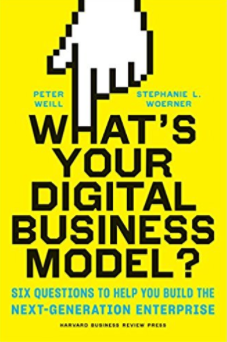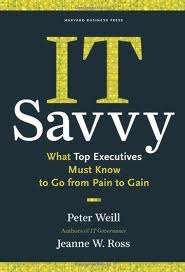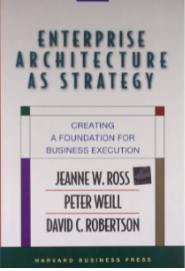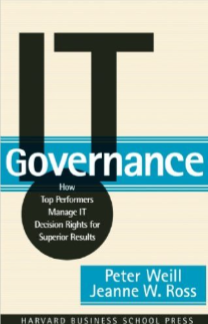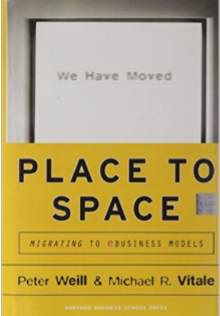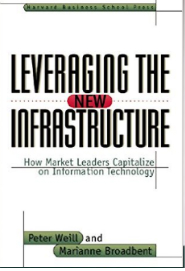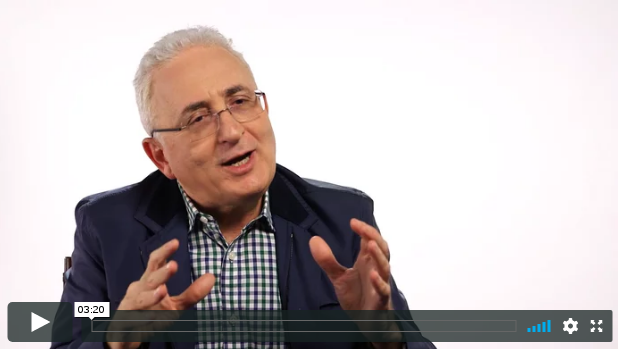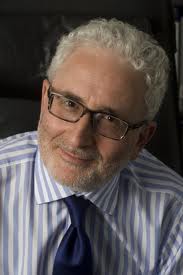
speaking topics
Business IntelligenceBusiness Strategy
Competition
Decision Making
Information & eBusiness Management
Information Technology
Leadership
Managing Change
Follow on Twitter
Connect on LinkedIn
announcing
Peter’s new book “What’s your digital business model: Six Questions to Help You Build the Next-Generation Enterprise”, alongside co-autor Stephanie Woerner was released April 2018. “An essential decision guide to navigate digitization, ask the right questions, and make the right choices.”
In his 2015 article for Sloan Management Review, Weill argues that companies need to do more to understand and prepare for life in the digital age.
Weill explains how companies can make money from digital disruption in a recent article with the Financial Review.
Weill and co-author Ritu Agarwal make the case for “softscaling” – automation that keeps customer connectivity as the focus – in their recent article for Sloan Management Review.
Peter Weill is the Chairman of the MIT Center for Information Systems Research (CISR) and a Senior Research Scientist at the MIT Sloan School of Management. His work centers on the role, value, and governance of digitization in enterprises.
Recognized in the top quarter of the Ziff Davis’s “Top 100 Most Influential People in IT”, Weill has co-authored five award-winning books, including the highly accessible bestseller, IT Savvy: What Top Executives Must Know to Go from Pain to Gain (2009), which describes the practices, competencies, and leadership skills non-IT managers need to succeed in the digital economy. His co-authored book, Place to Space: Migrating to eBusiness Models (2001), was named by Library Journal as one of the best business books of the year, and was reviewed by The New York Times. His journal articles and case studies have appeared in Harvard Business Review, Sloan Management Review and the Wall Street Journal.
A beloved educator and highly-respected speaker, Weill’s presentations and teaching have earned him accolades from executives and students alike, including the Outstanding Teacher award at Sloan. He advises and speaks regularly on IT issues with corporations and governments, including Aetna, IBM, Microsoft, and the World Bank.
Weill holds a BE from Melbourne University as well as an MBA, an MPhil, and a PhD in management information systems from New York University, Leonard N. Stern School of Business.
Doing Business Digitally
A digital business model describes how your enterprise will interact digitally with its customers and generate value. However, a great digital business model will often challenge the status quo in the enterprise. Using case studies of top performers like Amazon, Apple, Bloomberg, Banco do Brasil, Commonwealth Bank of Australia, Google, Netflixs and USAA, Peter presents a framework to help enterprises compete digitally with three capabilities: the content, the customer experience and the platform. He then asks the participants which are the most important capabilities for their digital business model and how will this influence their investment and capability building strategies.
Becoming More IT Savvy – And How It Pays Off
In a global, digital economy, companies need to use IT to deliver timely information, cost-effective operations, and rapid innovation. If IT isn’t a strategic asset in your company, it is a strategic liability. IT savvy companies—those who digitally transform —generate 20% higher profits than their competitors. Based on field-based research in hundreds of firms, Peter presents a concise, actionable framework for gaining value from IT. Illustrated by examples from top-performing global companies such as BMW, UPS, Danske Bank, Campbell Soup, 7-Eleven Japan, BT, State Street Corporation and Procter and Gamble, he outlines a set of capabilities and leadership actions required to make the journey to becoming more “IT savvy.”
Managing Total Digitization
Every day more and more business is conducted digitally. But CIOs budgets often only contain a percentage of the firm’s total digitization efforts. In many firms, process control, digital products, CAD, transmission, production (e.g. robots, media, financial products) and many other digital initiatives occur outside the IT budget and governance processes. Yet customers often expect all these digital assets to work together. And, more and more, the IT department is asked to operate these digital investments made outside the IT group (e.g. digital products). Peter will present some early findings from 10 case studies (e.g. BMW) and a survey of 600 firms and facilitate a conversation about how CIOs manage total digitization today and in the future.
Driving Superior Growth and Margin
Firms that reuse technology, systems, business processes, and expertise have CIOs who better meet business expectations, generate higher business value from IT, and perform better than their competitors. Not bad, but all reuse doesn’t pay off equally. Using data from research in reuse in over 1000 firms, Peter identifies the types of reuse that work. He presents a framework for reuse, a self-assessment tool and how to increase reuse to help improve firm performance, engaging participants to share their effective practices.
Making Commitments: Achieving Success in the Digital World
This talk addresses the oft-asked questions: “What are the most important factors to run a successful firm in digital world?” Drawing on 10 years of research, Peter presents a framework to identify the four key commitments a firm needs to make to thrive in the digital world: strategic choice making, working smarter, distinctive digitization and actionable assessment. After illustrating the framework with several case studies, Peter will discuss the management practices top performing firms use to meet those four commitments.
Thriving in Volatile Environments: Learning from Great Indian Managers and Their Softscaling
Knowing how to optimize business processes and technology may not be enough in increasingly volatile business environments. Success requires learning how to use data compassionately in response to changing new opportunities and risks. India is booming and often seems in chaos, so where better to study how firms thrive in volatile markets. Using in-depth case studies at Airtel, Hero Honda, Tata Motors, Max Healthcare and HDFC (financial services), Peter presents what makes their managers great and able to achieve average growth rates of more than 30% a year.
How Top Performing Enterprises Govern IT
Firms with superior IT governance have more than 20% higher profits than firms with poor governance given the same strategic objectives. These top performers have custom designed IT governance for their strategies. Just as corporate governance aims to ensure quality decisions about all corporate assets, IT governance links IT decisions with company objectives and monitors performance and accountability. The session will present insights for effective IT governance from MIT CISR studies of over 1000 firms in 60 countries examining how the best performers govern. Effective IT governance coordinates the five key IT decisions: IT principles, architecture, infrastructure, application needs and investment
Exploiting Five Digital Capabilities to Globalize Profitably
In this session Peter will describe the five global digital capabilities of Cosmo firms (companies that outperform their competitors in these global settings): scale, responsiveness, innovation, optimization and coordination. Cosmo firms are sophisticated companies that operate nimbly in multiple countries and pursue multiple strategic goals with a strong commitment to business digitization as a competitive edge. Many companies are seeking growth outside their home base and are growing at remarkable rates. Companies can only grow quickly in these complex global environments by simultaneously pursuing multiple strategic goals and effective digitization. And they perform better.
Enterprise Architecture as Strategy: Building a foundation for business execution
Firms that decide how they want to grow and then effectively manage their enterprise architectures have higher profitability, faster time to market, lower IT costs and less business risk. In this talk, Peter discusses how top performing firms create a foundation for business execution and growth based. These top performers have a digitized set of business processes and IT systems that efficiently and reliably execute the core operations of the company. Research at 200 companies has found that effective firms first choose their business process integration and standardization requirements. Peter will also present a framework to decide how to grow and the journey through four stages of architecture maturity that leads to more modular, innovative businesses.
Which Business Models Investors Prefer
As industry boundaries blur, the concept of business model—what a firm does and how it makes money—is replacing industry as a foundation for business strategy. In this session, Peter will characterize alternative business models and provide frameworks for rethinking IT investments to support targeted business models. He will address such key questions as:
- What are the business models used by the largest 1000 US firms?
- How have these business models changed over time? Which are most successful?
- What other business models makes sense for you enterprise?
Achieving Digital Transformation
Many leadership teams are digitally transforming their organizations to achieve a step change in performance. The goals of transformation vary across the firms but most frequently include: consolidating fragmented operations and vendors, improving the customer experience, digitizing and reusing core business processes, combining IT and operations and moving to a heavily outsourced model while focusing on the customer. In this session, Peter describes lessons learned from several firms who have successfully transformed their organizations, including: Airtel, BMW, Commonwealth Bank of Australia, DBS Bank, Danske Bank, Procter and Gamble, State Street Corporation, Tetra Pak and USA.
The Future of the IT Unit
In recent years, IT units have been working to ensure world class Run and Build services. As external business partners take on more responsibility for IT services, these services become table stakes. And as firms become more digitized many capabilities (e.g. analytics, digital product creation, apps) are moving out of the IT unit into other groups. In this session, Peter uses case studies from firms such as case studies such as USAA, TetraPak and Danske Bank to discuss options for the future value proposition of the IT unit.
Increasing Business-IT intimacy
Improving the intimacy between IT and the business unit leaders is all about value creation and the many conversations involved. Value is improving performance on a dimension that stakeholders find important. Companies that can communicate effectively about the value of IT create more value and have more business and IT intimacy. In this talk, Peter will present a framework for driving the IT value conversation Using case studies of successful IT-business intimacy, Peter will ask audience members to assess the kind of conversations they have now and where they would like to go.
How Effective CIOs Spend Their Time
As the world digitizes at an exponential rate, it is time to examine the future of the CIO. In this talk, Peter describes four types of CIOs based on how they spend their time. Using profiles of leading CIOs, and a real time participant survey, Peter will illustrate some trends and discuss: How do CIOs allocate their time? What is the impact on the firm performance? How do senior non-IT executives think CIOs should allocate their time? And, finally, what is the future of the CIO in three to five years?

